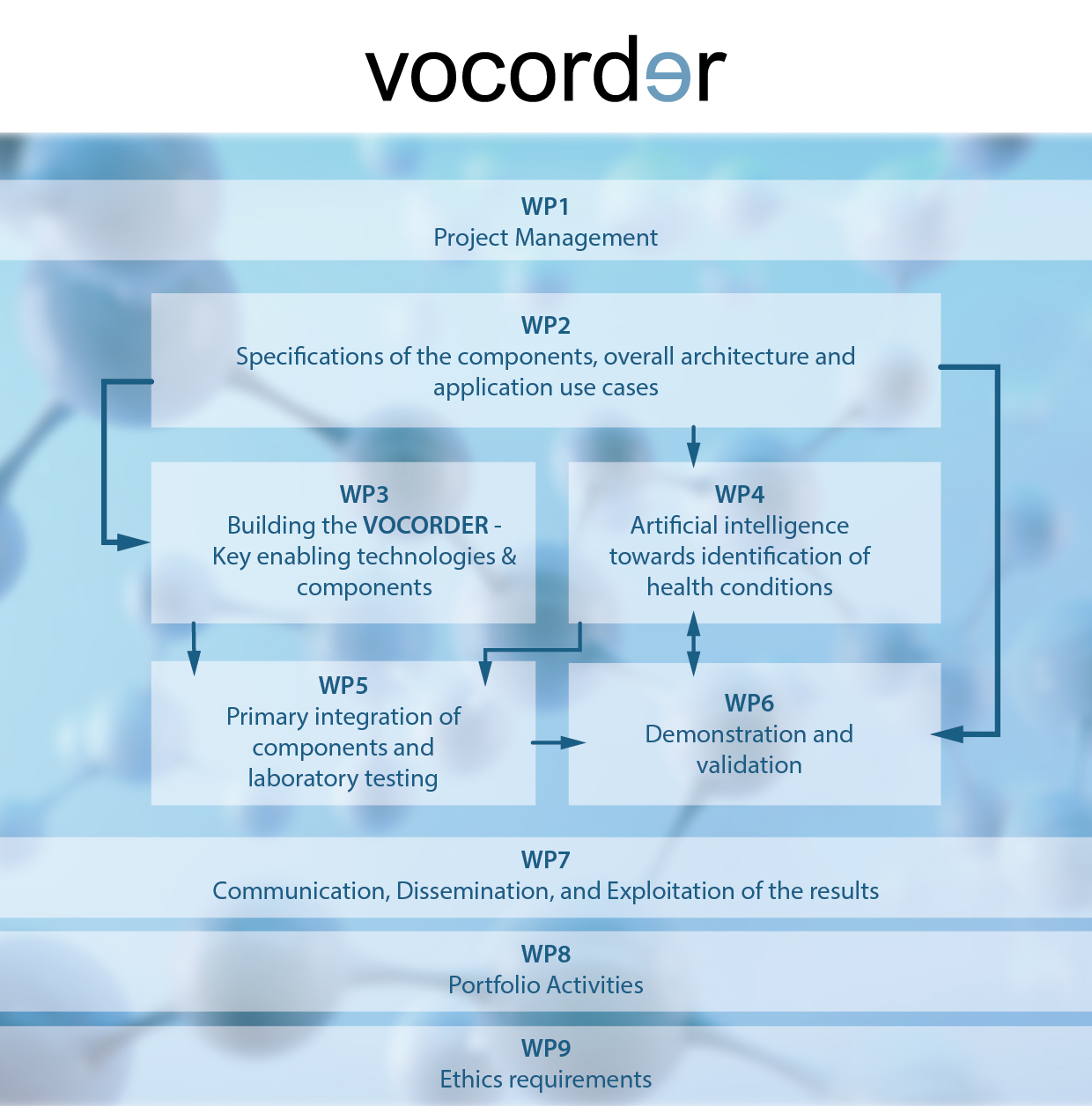Work Packages
Work package structure
Explore the diverse range of our work packages, from project management to technology development, AI integration, and clinical trials. Each work package is designed to contribute specific components or expertise to the overall project, ensuring a comprehensive approach to developing and validating the VOCORDER technology.

Work package videos
2:14
1:08
2:45
1:21
WP1: Project Management
Objective: To oversee the overall coordination and management of the VOCORDER project, ensuring alignment with objectives and adherence to timelines and budgets.
– T1.1 Project Management and Coordination: Led by MITERA, this involves overall coordination of the project, managing communications, and ensuring compliance with agreements and objectives.
– T1.2 Quality Assurance and Risk Management: Focuses on maintaining the quality of deliverables and monitoring quality assurance procedures, with MITERA as the leader.
– T1.3 Data Management Plan: Led by NEURALTECH, it aims to establish a comprehensive data management strategy for the project, ensuring data quality and security.
WP2: Specifications and Use Cases
Objective: To define the specifications for VOCORDER components and outline the application use cases.
– T2.1 Literature Review on VOCs: ETH leads this task, reviewing scientific literature to identify key VOC biomarkers related to health conditions.
– T2.2 Specifications of Components: Led by ALPES, this task involves defining the specifications for the various components of the VOCORDER device.
– T2.3 Design of Clinical Settings Validation: MITERA leads the creation of detailed protocols and SOPs for clinical studies.
WP3: Key Technologies and Components
Objective: To design and fabricate the tailored components essential for the VOCORDER device.
– T3.1 QCL and ICL Arrays: ALPES focuses on designing DFB-QCLs and DFB-ICLs arrays tailored for VOC detection.
– T3.2 Multi-pass Cell Development: EMPA is responsible for adapting multi-pass cell designs for the VOCORDER analyser.
– T3.3 Driving Electronics: EUL leads the design and implementation of the electronic drivers for the laser sources in the device.
WP4: Artificial Intelligence for Health Identification
Objective: To develop AI algorithms for identifying health conditions based on breath analysis data.
– T4.1 Annotation of EMR Data: Led by AIDEAS, this involves integrating and processing electronic medical records for AI analysis.
– T4.2 Annotation of Spectral Data: ICCS leads the task of analyzing high-resolution spectra from breath samples using machine learning techniques.
– T4.3 AI-based Correlation Analysis: AIDEAS leads the development of deep learning models to find correlations between spectral data and health conditions.
WP5: Integration and Laboratory Testing
Objective: To integrate the VOCORDER components into a functional system and conduct laboratory testing.
– T5.1 Integration of Components: ARGOS is responsible for assembling the device, ensuring all components work harmoniously.
– T5.2 Cloud-based Data Analytics: AIDEAS leads the integration of AI pipelines into a cloud-based framework for data analysis.
– T5.3 Lab Device Testing and Validation: EMPA conducts rigorous testing against established standards to ensure device reliability and accuracy.
WP6: High-Level Integration and Validation
Objective: To validate the VOCORDER device in real-world settings and assess its performance.
– T6.1 Clinical Setting Validation: MITERA oversees the validation of the device in clinical environments, including operational training and user feedback collection.
– T6.2 Assessment of Validation: ETH focuses on applying structured methodologies to assess the device’s impact and efficacy.
– T6.3 Citizen/Patient Technology Acceptance: METIS conducts research to gauge public acceptance and perception of the VOCORDER technology.
WP7: Dissemination and Exploitation
Objective: To communicate the project’s progress and results while developing strategies for future exploitation.
– T7.1 Dissemination Plan and Collateral: NEURALTECH leads the creation of a comprehensive dissemination plan and development of communication materials.
– T7.2 Business Models and Exploitation Plans: NEURALTECH develops a business plan based on the VOCORDER technology, analyzing market potential and user needs.
– T7.3 IPR Management and Patenting: VUB leads the identification and management of intellectual property rights, ensuring the protection and proper use of project innovations.
WP8: Portfolio Activities
Objective: To build synergies with other projects and stakeholders for a broader impact in healthcare technology.
– Tasks 8.1 to 8.4: These tasks involve collaborative efforts with other entities, participation in relevant events, and engagement in outreach activities to foster a community around continuous healthcare technologies.
– T8.1 Collaboration with other projects funded under 2022 EIC Pathfinder challenge call.
– T8.2 Participation in meetings called by EIC to provide updated on project`s development.
– T8.3 Organization and participation in collaboration meetings to present the latest project`s advancements.
– T8.3 Engagement in outreach events focused on continuum of healthcare.
WP9: Ethics requirements
The objective is to ensure compliance with the ‘ethics requirements’ set out in this work package.
